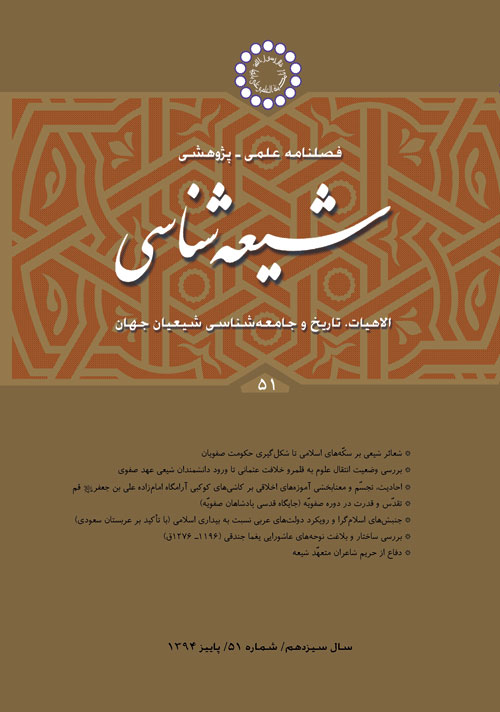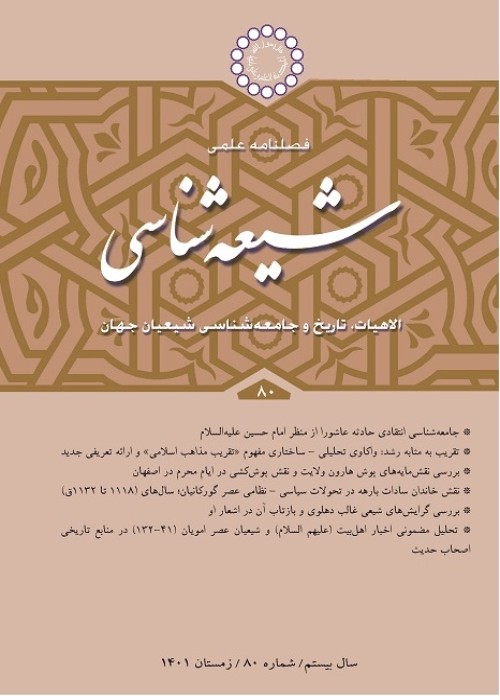فهرست مطالب

فصلنامه شیعه شناسی
پیاپی 51 (پاییز 1394)
- تاریخ انتشار: 1394/08/14
- تعداد عناوین: 7
-
-
صفحه 137
-
Page 7Coins are among the most important signs of governments, and any sign or motto carved on coins shows the tendencies of the owners. Some governments formed in Shiite regions, or by dynasties supporting Shiite Imams, would carve Shiite mottos on their coins. In view of Arghuns oppositions with Sunnites and increase of Shiite power after the fall of Baghdad, he carved the motto of Ali Wali-Allah on his coins. In later periods, the Shiite rites spread more and Imams names were carved on coins from the period of Ghāzān Khan. Under Muhammad Khudā Banda, two Shiite and Sunnite coins were minted, and this continued up to the Safawid period. The present study tries to investigate the following questions: Were there any Shiite motto on the coins before the formation of Shiite governments? and Why were the Shiite rites carved on the coins? The results show that before the formal establishment of Safawid dynasty in Iran, various rulers minted many coins with Shiite signs with certain political, social and religious motivations in various historical eras. Therefore, the present study covers the period before establishment of Safawid dynasty. The research method was historical research method based on historical and library resources along with coinage studies.Keywords: coin, the Shiite mottos, the Shiites
-
Page 27Stability of Shahrukh Mirzas governance over Teymurs vast areas of conquests in Iran was necessary for political-cultural relations with Ottomans for preventing Āq-Quyūnlū and Qarā-Quyūnlū Turkmens disobedience and controlling power struggle among Teymurs offspring in western Iran and Arab Iraq. More than four decades of good relations up to Shahrukhs death 850 AH caused scientific migration of Ottoman scientists to Iran and transference of the traditions of Iranian schools to Ottoman land in their return. Although this scientific trade between two countries continued up to the end of the rule of Sultan Hussein Bayiqrā in Harāt, the fall of stable governments and the establishment of Safawid rulers caused another group of non-Shiite scholars to migrate to Ottoman land.
Ottoman kings supported them and seized the opportunity to transfer the sciences and traditions of Iranian schools and formation of Ottoman period of sciences. Ottoman Empire used those emigrants in offices such as special doctors, military jurists, and school teachers, sending them to all parts of Ottoman Empire. Meanwhile, Safawids also attracted and welcomed skilful Shiite scholars such as Sheikh Bahāuddīn Āmulī and Ali bin Hilāl Karakī to promote and diffuse sciences throughout Safawid territory.Keywords: Safwids, transference of sciences, Shiite scholars, Ottoman, Teymurids -
Page 41The philosophy behind humans existence is verily remembering and worshiping God. Muslims skilful artists have used their talent in introducing the principles of Islamic knowledge by creating a spiritual atmosphere in Islamic society in various forms and themes. For example, the walls of the holy shrine of Ali bin Jafar in Qom (built in early years of eighth century) has been decorated by eight-pointed stars that have inscriptions in Naskh calligraphy in their margins. The large number and small size of the tiles as well as inscriptions with literary and religious contents in Naskh calligraphy in two- centimeter-margins of the stars has made reading the valuable inscriptions difficult. The inscriptions contain a variety of themes such as Quranic verses, the Prophets sayings, and Persian poems. This study aims at investigating the themes of hadiths inscribed on those tiles with an approach of transferring messages of individual, social and legal morality to Muslim society. Besides, slight differences between those hadiths and their sources were investigated. The reasons for using such contents on the walls of that shrine seem to be the importance of their educative effect, compensating the scantiness of textual sources and enough copies available for ordinary people, and creating a spiritual atmosphere.Keywords: Ali bin Jafar's shrine, inscription of hadiths, golden Kawkabī tiles
-
Page 65Safawid kings enjoyed a sacred-like position. They were said to be infallible and enjoyed God-given knowledge, specific imperial fortune, ability to do miracles and predict future events. Kings house was considered to be sacred and people would sit there for some times. Anything that he touched would become sacred and would get the power to heal patients. Due to such a position, the king would let himself ignore the religious precepts and do wrong deeds. People were afraid of the kings curse. Manipulating the kings orders and drawing his face were forbidden. Such beliefs originated from Qezelbāshs extremist beliefs and the kings status among ordinary people. The present research studies the factors, results and signs of the sanctity of Safawid kings and uses a descriptive- analytical method based on original sources to prove that Safawid kings enjoyed a sacred-like status different from their predecessors.Keywords: Safawid kings, sanctity, power, divine charisma
-
Page 87Islamic Awakening and the ensuing changes in political regimes as well as the crises in some countries of the Middle East and Northern Africa has had a widespread effect on political and security relations in the region in a way that regional and trans-regional players have rallied against one another to form the changes for their own benefits. The emergence of Islamic Awakening caused Arab countries, Saudi Arabia in particular, to consider it a threat for themselves and exert the policy of active interference in the region to block the wave of the changes behind their frontiers and prevent disturbing the balance of power against them (Karami, 1393 SH, p.1). The policies of Saudi Arabia against Islamic Awakening in its own country as well as the Middle East region and Northern Africa are understood in line with increasing the security and in the framework of offensive realism. To test this hypothesis, we used the theories of defensive and offensive realism.Keywords: Islamic Awakening, Saudi Arabia, Islamist Movement, realism, security
-
Page 119The Shiite poetry is a fruitful branch of the tree of ritual poetry with a heroic, painful militant spirit, whose most prominent manifestation is seen in the Ashuras poems. Yaghma Jandaqi is one of the best-known poets of the period known as literary return (Bazgasht-i Adabi) whose fame is due to Ashuras poems and innovating the poetical format of elegy (noha). He created this format by making some changes in the structure of ode (qasida), and the structure of his elegies can be classified into four groups. Although Yaghma was not a scholar or scientist, not learning the rules of poetry from a teacher, his Ashuras elegies are full of various literary techniques, and numerous literary innovations are seen in his poetical imageries. More interestingly, he with much sagacity has not used much formality in his poetical imagery. This has made this kind of poems understandable even for ordinary people. Having investigated literary techniques in Yaghmas elegies in two groups of literal and semantic rhetoric, we note that since elegies were recited in group and with beating ones chest, this poetical format has been full of alliteration, pun, and repetition, which increase the musical weight of the speech. Among the semantic literary techniques, literary devices such as contrast, symmetry, simile, and explicit metaphor which are understandable for all people have been mostly used.Keywords: Yaghma Jandaqi, Ashura's poetry, elegy, ode, rhetoric
-
Page 137Since some Shiite poets defended the sanctum of Shiism and its intellectual foundations by resisting against the oppression of unjust rulers and opponents of Shiism, they were always subject to various impairments and slanders. Some opponents of Shiite school due to non-literary factors such as bias, religious prejudices, political leaning, etc. began to disgrace and disrepute prominent Shiite poets, presenting unreal images of them. In this way, committed poets such as Mahyar Deylami, Komeit bin Zeyd, Sayyid Hemyari, Kathiyyar Izza were introduced as norm-breakers and Rāfiḍī (out of religion), and were accused of corruption and perversity. They were also accused of not committing to Shiism, no sincerity, being associated with rulers, indiscretion, foolishness, etc.Keywords: Shiite poets, Rāfiḍī, promiscuity, business, foolishness, prudery


